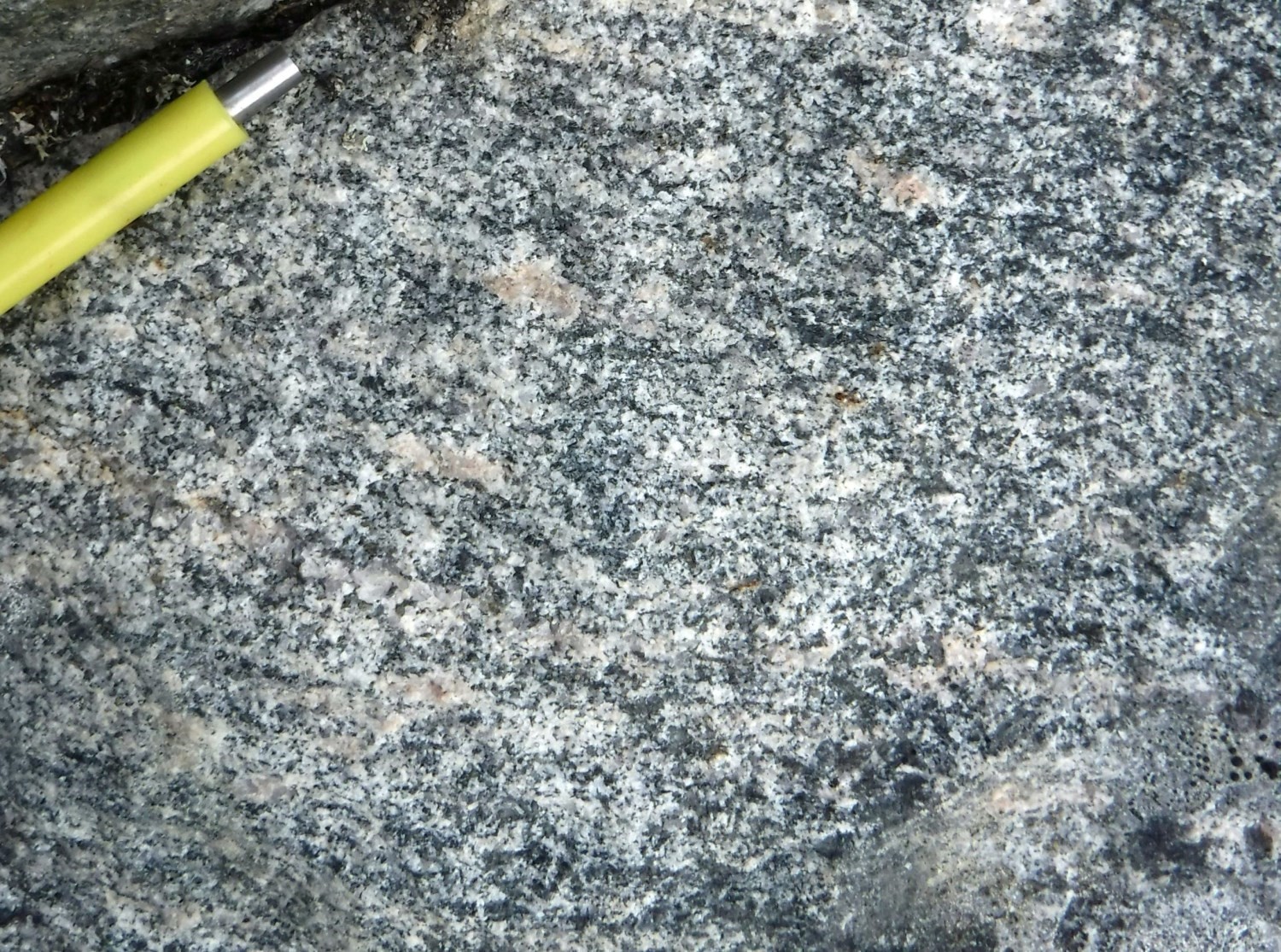
DISCLAIMER: This English version is translated from the original French. In case of any discrepancy, the French version shall prevail.
| Author: | Vanier and Lafrance, 2020 |
| Age: | Archean to Paleoproterozoic |
| Stratotype: | None |
| Type area: | Guichaud River area (NTS sheet 35K01) |
| Geological province: | Churchill Province |
| Geological subdivision: | Ungava Orogen / Kovik Lithotectonic Domain |
| Lithology: | Granodiorite |
| Category: | Lithodemic |
| Rank: | Suite |
| Status: | Formal |
| Use: | Active |
None
Background
The Arviq Suite was introduced in the Sirmiq Lake area (Vanier and Lafrance, 2020) to group foliated potassic felsic intrusive rocks of the Kovik Lithotectonic Domain.
Description
 Unit ApPavi1 consists mostly of magnetic granodiorite and includes some quartz monzodiorite and monzogranite. It is well foliated, non-magnetic and medium grained. The rock is white to beige in altered patina, while medium-light grey in fresh exposure. Outcrops can be homogeneous, but most are characterized by the presence of a coarse-grained to pegmatitic pink granitic phase, which is injected in diffuse contact into granodiorite. Some of these injections are now visible as millimetric to centimetric bands subparallel to foliation, or cutting it at a small angle. They generally represent 5% to 15% of outcrops, but can locally reach 35%, giving an almost gneissic appearance to the rock.
Unit ApPavi1 consists mostly of magnetic granodiorite and includes some quartz monzodiorite and monzogranite. It is well foliated, non-magnetic and medium grained. The rock is white to beige in altered patina, while medium-light grey in fresh exposure. Outcrops can be homogeneous, but most are characterized by the presence of a coarse-grained to pegmatitic pink granitic phase, which is injected in diffuse contact into granodiorite. Some of these injections are now visible as millimetric to centimetric bands subparallel to foliation, or cutting it at a small angle. They generally represent 5% to 15% of outcrops, but can locally reach 35%, giving an almost gneissic appearance to the rock.
 Granodiorite contains 8-25% K-feldspar, 15-35% quartz and 5-15% ferromagnesian minerals, the latter marking foliation. Biotite is present on all outcrops, whether or not associated with hornblende, which is then present in similar proportions. These two ferromagnesian minerals are fairly chloritized. Although it occurs as fine disseminated crystals, K-feldspar is locally concentrated in some bands as 0.5-1.5 cm long phenocrystals.
Granodiorite contains 8-25% K-feldspar, 15-35% quartz and 5-15% ferromagnesian minerals, the latter marking foliation. Biotite is present on all outcrops, whether or not associated with hornblende, which is then present in similar proportions. These two ferromagnesian minerals are fairly chloritized. Although it occurs as fine disseminated crystals, K-feldspar is locally concentrated in some bands as 0.5-1.5 cm long phenocrystals.
In thin section, the general fabric is heteroganular and interlobed with a few grains of amoeboid quartz having subgrain extinction. K-feldspar is of microcline type and plagioclase is slightly sericitized. Epidote, apatite, sphene and magnetite are the accessory phases.
Thickness and Distribution
The Arviq Suite has only been observed in the southern part of the Sirmiq Lake area (Vanier and Lafrance, 2020), in the Kovik Lithotectonic Domain. Some units of the Kovik Complex will be reassigned to the Arviq Suite as mapping of the Kovik Lithotectonic Domain progresses.
Dating
None.
Stratigraphic Relationship(s)
Enclaves or discontinuous decimetric layers of monzodiorite, similar to that of the Gastrin Suite, were observed locally in the Arviq Suite. Granodiorite also appears to cut the tonalite and quartz diorite unit of the Nanuk Complex, although in some cases contacts are not very clear. However, granite of the Nunatak Suite clearly intrudes the Arviq Suite.
Paleontology
Does not apply.
References
Publications Available Through SIGÉOM Examine
VANIER, M A., LAFRANCE, I. 2020. Geology of the Sirmiq Lake area, Ungava Orogen, Nunavik, Quebec, Canada. MERN. BG 2020-02, 1 plan.
Suggested Citation
Ministère de l’Énergie et des Ressources naturelles (MERN). Arviq Suite. Quebec Stratigraphic Lexicon. https://gq.mines.gouv.qc.ca/lexique-stratigraphique/province-de-churchill/suite-arviq_en [accessed on Day Month Year].
Contributors
|
First publication |
Isabelle Lafrance, P. Geo., M.Sc. isabelle.lafrance@mern.gouv.qc.ca; Marc-Antoine Vanier, Jr. Eng., M.Sc. marc-antoine.vanier@mern.gouv.qc.ca (redaction) Mehdi A. Guemache, P. Geo., Ph.D. (coordination); Benoit Charette, P. Geo., M.Sc. (critical review); Simon Auclair, P. Geo., M.Sc. (editing); Céline Dupuis, P. Geo., Ph.D. (English version); André Tremblay (HTML editing). |

